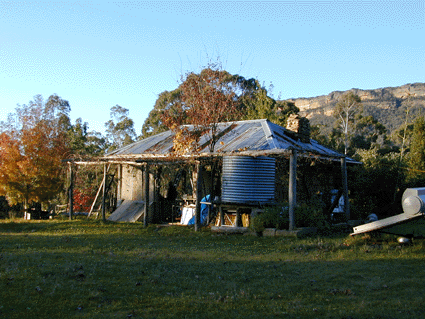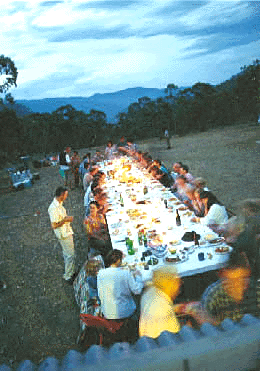 Chant's Hut
Chant's Hut
BURRAGORANG INTERNATIONAL ARTISTS WORKSHOP
FROM AN ARTICLE BY ALISON CLOUSTON
PUBLISHED IN THE AUSTRALIAN MONTHLY REVIEW, MARCH 2004
Circled by sandstone escarpments in a deep valley of the Blue
Mountains Heritage area, twenty-one artists, invited from around
Australia and the world, camped together to make art in the Australian
environment. Held in the Burragorang Valley in April 2003, this
event joined a network of similar Workshops world-wide, linked
through the Triangle Arts Trust, a London based not-for-profit
organization. The Workshops bring together artists from diverse
cultures for an intensive two weeks of work, conversation, exchange
of ideas and practice. They are often sited in a place that is
remote and inspiring. An Open Day allows public access to the
Workshop, strengthening interactions with neighbouring and visiting
communities. The Burragorang event is the first such workshop
in NSW, joining one in Western Australia, and others in more
than twenty different countries around the world, from Trinidad
to New York, Botswana to Britain.
As if the drought was breaking, rain veiled the cliffs on the
Open Day of the Burragorang Workshop. Visitors splashed through
mud to open the farm gates on the track in from the bitumen.
Each gate was emblazoned with Aboriginal words written in earth
pigments by Waanyi artist Judy Watson. Names and placenames of
the Gundungurra people, , the traditional owners of country here,
proclaimed the indigenous history of this place in the very medium
that signified colonial land enclosure and dispossession - closed
gates, fences, and the written word. With each gate to be opened
and carefully closed, the Open Day visitors made a journey, historical
and symbolic, on their way to meet the 4wd vehicles that would
ferry them deep into the valley below. Down at the camp, they
would find the Gandangara presence reasserted in the ruins of
the nineteenth century selector's hut, their ochre names drawn
by Judy on the sandstone blocks of the surviving chimney.
The Burragorang Workshop artists all responded to this place
and its entwined natural and human histories. Pat Hickman from
Hawaii found an old wire bed frame pierced by a eucalypt regenerating
in a paddock. She was intrigued by its history, how it came to
be there - the sagging wire mesh springs had once borne the bodies
of recruits for the military during the Second World War, when
a training camp was established in the lower Burragorang Valley.
Over the years the beds have been taken all over the valley for
various uses, such as the stockyard built from them for the muster
and capture of brumbies. Pat used animal membrane, stretching
pale and translucent gut over the wire and trunk, the rusty springs
and rough bark imprinting onto the delicate skin. Pat's works
suggest that nature and culture are separable only by a thin
and elastic membrane, a permeable organ filtering nutrient for
the soul. To crown the dome of a termite mound, Pat twined gut
in an openwork net. It was later eaten by dingoes, a neat cycle
of material, gut to gut.
The Burragorang artists often used local materials so that the
works were reabsorbed by the environment. Ramlan Abdullah (Malaysia)
made basket-like circles in the eucalypt forest with the abundance
of twigs that are dropped there. Gradually they relinquished
themselves to gravity, sagging into a graceful contoured mulch.
In the rain, some of the works were slowly returning to the earth,
revealing a beauty in their processes of creation and erosion.
Christine Christopherson, an artist from the Kakadu area, collaborated
with Silvana Giordano from Melbourne. Using the sticky orange
Burragorang clay, they plastered gigantic totemic figures on
the trunks and branches of several trees. Looming round the camp
and from the perimeters of the forest, these guardian figures
were all feminine, their origins in Christine's paintings and
her struggle for land rights in her mother's country. Powerful,
patiently waiting, foreboding, they became ghostly as their bodies
dissolved in the rain. Running red stains on the white box bark,
their arms reaching out along the branches and dividing in fingers
like rivulets in flood-time, their breasts and faces dropped
in chunks to the ground. Eventually only their watchful eyes
and blood-ochre traces remained. The friendship between these
artists, Christine, Iwatja language group, Silvana, of Italian
descent and the Thai painter, Kapkaew Suwannakudt was evidence
of the connections made possible by the Workshop. Many will remember
them together outside a tent, translating from Thai to English
a book of temple paintings that Kapkaew had illustrated, or hoisting
Silvana up a tree with buckets of mud.
Working across a kangaroo trail, Caroline Ho-Bich Tuyen Dang
(from Melbourne) touched on the connections of animal and human
movements. Embroidered amongst leaf litter, her geometric patterns
of yarn encircled the trunks of trees, mapping the unseen roots
and routes below the surface, resembling spider web, and paths
that radiate from ant or human settlements. Caroline's recent
work had overlaid maps of Australian and Vietnamese cities; the
experience of working in this bush camp caused a shift of perspective
- this mud-map intuited and intersected the tracks of animals,
a sideways reflection on the nature of culture and the culture
of nature. Later the luminescent lines of wool were knitted by
the feet of 'roos and the woollen loops that ascended the trunks
of eucalypts were taken by birds for nests.
The perceived divide of nature and culture, like the scarps of
the dividing range surrounding the campsite, is continually eroding
and collapsing. Kjell Samkopf (Norway) made recordings of artists
and stones. He assembled seventeen artists in a grove at dawn,
equipped with a 'score' based on a numerical rendering of the
word 'Burragorang' and rocks found underfoot. Harmonising with
birds and occasional aeroplanes, the rock-click patterns of sound
were uncannily like the call-and-response chorus of a local frog
species -yet Kjell could not have heard it at this time of year.
We draw from natural processes so many of the metaphors that
sustain our understanding of the world. The Burragorang Valley
presented Sri Lankan artist Bandu Manamperi with a powerful image.
Around the huge sandstone hearth and chimney of the 1890s slab
hut on the site, he performed a slow dance ritual, alluding to
the creative and destructive force of fire, both in nature and
in human affairs. Making connections between the bushfire-ravaged
landscapes near the site and his war-ravaged homeland, Bandu
contrasted this destructive force with the warmth and comfort
of the domestic home-fire. For a long time after the camp, the
soft grey ash of the fireplace carried the imprint of his body.
Two weeks is a short time for artists to evolve new work, to
get to know one another and to make connections and collaborations.
Yet the brevity and intensity of the Burragorang experience enabled
some extraordinary things to happen. It was an opportunity for
the artists to work away from the realities of their every day
lives, to enter and inhabit a rugged new world, filled with strange
new species, geologies and stories. For the artists and the visitors,
the secretive site enclosed by sandstone walls enhanced the sense
of a special place. Play, spontaneity, experimentation and cross-disciplinary
work could erupt at any time. The works may last a minute.
Finally, just as the land has absorbed human change before, regrowth
forest crowds the hills and termites mine the buildings, so the
artworks will be swallowed up and digested. Soon, we hope, another
twenty artists will come to transform and be transformed by this
place.
|

